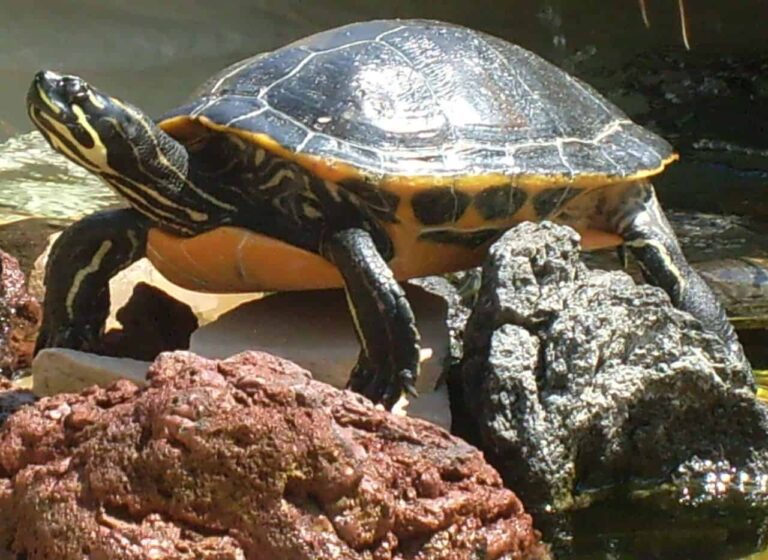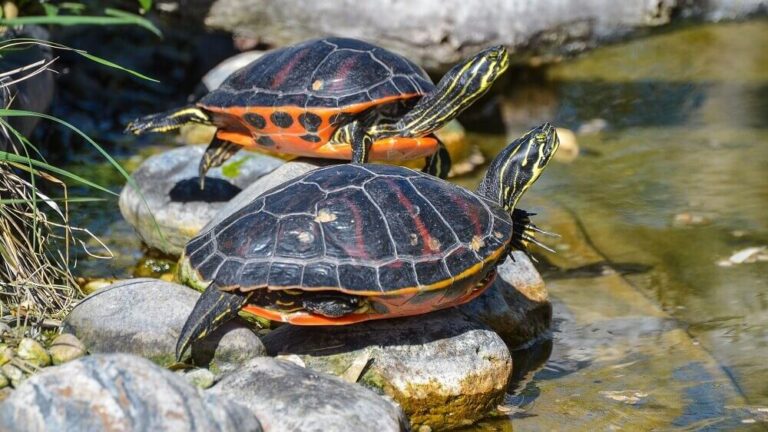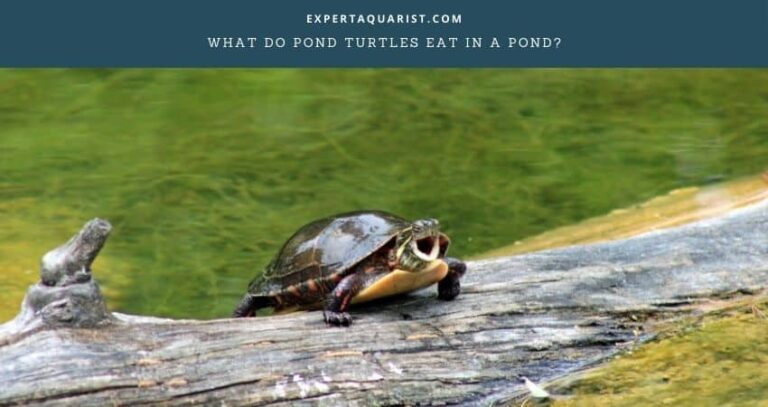If you have a turtle, the chances are that you are familiar with the basking of the turtle underneath the sun. While you may think they do it for pleasure and relaxation, lights, especially UVB lights, have a particular role in a turtle’s life.
UVB light is essential for vitamin D3 synthesis, calcium abosorbtion and prevent Metabolic Bone Disease. And not just the regular UVB, a pet turtle also needs UBA lights for a healthy and happy life.
Today’s post, I am going to discuss everything you need to know about UVB lights for turtles. It will include-
- What is UVB light?
- Why turtles need UVB lights?
- What is the risk of over and under exposure to UVB lights?
- Best UVB light recommendations for pet turtles.
So, for your pet’s sake, do read through the article to set up the right UVB and other light sources for the turtle.
What is UVB light?
To put it simply, UVB light is a kind of ultraviolet rays coming directly from the sun through the cosmic rays into our world.
So, first off, let’s see what does ultraviolet rays mean, right?
The ultraviolet rays of the sun consist of three different beams mainly. All these lights have a different wavelength, and these all are influential on human skin. Similarly, these UV rays also affect the skin and health of the reptiles, especially the turtles.
So, it is vital that you know the positive and negative sides of UVB lights on them. However, let’s get back to the focusing point.
I said that you would see three kinds of UV lights, but only two of them are familiar with us.
These are-
- UVA light: It has the longest wavelength
- UVB light: It comes with the medium wavelength.
The UVC has the shortest wavelength and least familiar to us.
However, UVB rays are linked with the UVA rays and have higher energy diffuser capacity despite having shorter wavelengths. While optimum exposure to UVB is helpful for the turtle’s, overexposure to it will cause endless suffering for the pet.
So, let’s now get to know the effects of UVB rays on turtles. Besides, we will also see UVA effects as part of the complete lighting guidelines on turtle lighting.
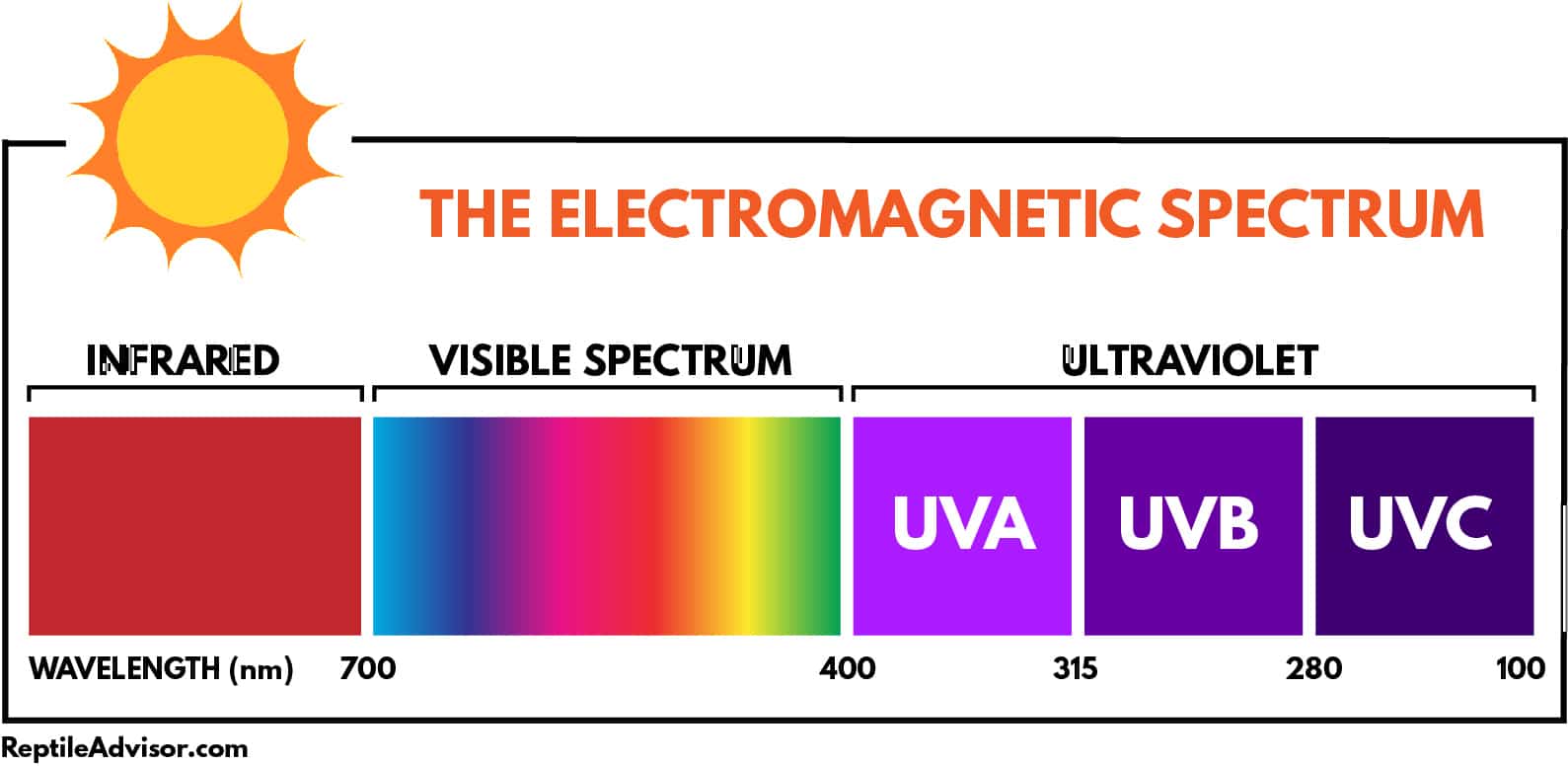
What Do We Mean by Full Spectrum Lighting?
When we talk about UVA and UVB light and its importance in the life of turtles and reptiles, the full-spectrum lighting term almost eminently comes forward.
DuroTest Corporation first introduced the term in their Vita-Lite™. It was defined as a color rendering capacity above 90. The CCT, aka, correlated color temperature between 5500K-6800K, is also linked with the full-spectrum lighting. Its UV light was close to natural daylight in the open sky.
These days, we apply the term full-spectrum to define the fluorescent lights that generate the lights of the 3entire visible spectrum. It does so in a similar energy level.
With modern technology, these days, various lighting sources can emit the full-spectrum and bring several health benefits for the reptiles, especially the turtles.
The difference between full-spectrum and wide spectrum lighting
It often happens that pet lighting manufacturers mislead their advertisements. Consequently, your pet reptiles and turtles face complications, even death. So, it is essential to identify the terms these manufacturers use.
One such significant term is a full-spectrum and wide spectrum. Since we have discussed the full spectrum lighting in the previous section, let’s move to the next one.
The wide spectrum only generates a few numbers of visible lights and wavelengths. It doesn’t create the UVA and UVB light. Whereas, the full-spectrum lighting can produce the entire visible lighting along with the UVA and UVB lights.
However, few manufacturers kept using the wide-spectrum term to manipulate the pet owners and sell their products. Henceforth, the next time you see wide-spectrum written in any light source, know that there doesn’t produce UVB light.
The Twist: 6% is higher than 10%
The pet light manufacturers often mislead the pet owners with their faulty play of %. They usually tag the lights 10%, and most owners will think it is better compared to the light labeled 6% on it.
But the advertised percentage (%) isn’t the focus when it comes to UVB lights. Instead, first, know the actual UVB range of the light. For example, a 40% lighting source with 6% UVB emission is better than the light with a 20% source but 10% (the advertised percentage) for the UVB range.
Thus, 6% becomes better than 10% here. So, next time you purchase the UVB light, don’t forget to see the actual emission capacity.
Importance of UVB Lights For Turtles
To sum up, UVB lights play a crucial role in the health of all reptiles, not just turtles. The lack of UVB light will cause several major issues to the turtles that may even lead to the premature deaths of the wonderful creature.
But why do I emphasize the UVB light? Good question.
Here’s the answer.
Proper exposure to UVB lights helps the production and maintenance of Vitamin D3, a life-saving ingredient, in the turtle’s body. D3 vitamin is directly responsible for the optimal support and use of calcium in the turtle’s body, without which their shells will start deteriorating.
Nonetheless, the most noticeable effects of not getting UVB exposure and failing to maintain an adequate level of Vitamin D3 will cause the following concerns for turtles.
- Reduced shell growth rate and decay of the mature shell.
- Reduced bone growth and decay.
- At the worst, immature death of the turtles.
Unfortunately, I have seen many turtle owners are little aware of the UVB rays’ importance on their turtle life. They wonder what happened when the turtles fall sick or die.
And what’s more surprising is that most turtle keepers think that only UVB light is essential for the turtles, not UVA lights.
How wrong they are!!!
The importance of UVA lights in a turtles’ life
While most turtle owners ignore the significance of UVA lights, unlike the UVB ones, these lights too play a crucial part in the turtles’ health.
Here, we put up the main reasons as to why UVA is as essential as UVB.
- UVA light is responsible for controlling the metabolism and activity level of the turtles.
- UVA light promotes healthy mating and breeding activity to a large extent.
- It helps the turtle to control its ever-changing mood.
And since UVA and UVB light is visible to the turtle eyes, it gives their world a new dimension. Without these lights, they may not be able to survive as successfully ad they are at present.
The importance of UVA and UVB light being said is that natural and artificial lighting sources are also essential for the turtles’ survival.
Why Do Turtles Need Sunshine and Lighting?
We now know why both UVA and UVB rays are essential for a turtle. But are there any other requirements that natural or artificial lighting and sunshine fulfill? And also, why do the turtle bask most of the time?
The answer to all these questions frequently leads us to the following three reasons.
- Regular and extended basking prevents bacterial attacks on the turtle and keeps them healthy.
- Since turtles are cold-blooded animals, they need an external heating source to keep themselves warm. The sunshine and other lighting sources act as a warming source for the turtles to regulate their body temperature.
- Circadian rhythms, also known as the daily activities of a turtle, is controlled with the exposure of lighting source. Without proper light, turtles feel stressed.
Factors Affecting UVB and UBA Rays
I have been reemphasizing from time and again that UVB rays are vital- for the health, mood, and breeding of the turtles. So, turtles don’t miss a chance to collect these rays through proper basking. However, as a turtle owner, you need to know various factors that will regulate the natural UVB rays. This information will help you understand when and how to arrange the artificial UVB sourcing (described in the next section).
The natural happenings that will regulate UVA and UVB rays are:
Day time
UV rays are not found in similar amount throughout the day. Instead, from 10 a.m. to 4 p.m., sunrays remain strong enough to provide the highest UV rays. It happens because the sun has to cover the least distance during this time from the earth.
Season
When the sun is set in a higher beveled angle, it naturally intensifies the UV rays exposure. This means during Summer and Spring, the earth receives the most UVA and UVB rays. Nonetheless, the UV rays are active too during winter and fall seasons.
Ozone
These days, due to the overexposure of the greenhouse gases, the protective ozone layer of our earth is getting thinner and thinner with each passing day. So, our planet and likewise, turtles, are receiving excess UV rays. Not good at all!
Cloud
During the cloudy days, turtles will have the least exposure to UVA and UVB rays. It happens because the cloud and also dense fog will filter a good portion of UV rays to safeguard the surrounding.
Latitude and altitude
At the equator, UV exposure is higher than the polar areas. Similarly, areas with high altitudes receive more UV lights. So, if you are in a mountain area with the turtle, it will be more exposed to the UV rays.
While you cannot control these natural forces, you can arrange artificial sources of UVB light for your favorite turtle.
Some Artificial Sources of UVB Lightings
Besides the natural sunlight, you will find three different kinds of sourcing for UVA and UVB lights. These methods are easy to apply for the turtle and won’t cost you much. The sources are:
Linear Fluorescent Light
For turtles, you will need specially designed linear fluorescent lights that are mainly made for heating reptiles. These specialized lights generate a modest yet essential amount of UVA and UVB days while producing minimal heat. The light has a beautiful color spectrum that will attract the turtle to go near it and bask.
Compact Fluorescent Light
It has all the good qualities of the linear counterpart but comes with another benefit. These lights have a fixture with a reflector style that makes it more productive and less costly. Usually, turtles like the EXO TERRA REPTILE UVB 100 BULB because it produces just the right amount of UVB necessary for the basking and enjoys the relaxed period.
Mercury Vapor Bulbs
Apart from the UVB ray generating capacity, Mercury vapour bulbs produce quite the right amount of heat, so it is useful during the wintertime. Therefore, if you think that the turtles need a warm basking area and a copious amount of ardent UVB sourcing, equip the turtle house with the mercury light.
However, these lights ate not suitable for small turtle houses due to the extreme heat emission capacity. So, keep an eye on it. Check out our review of exo terra solar glo mercury vapour bulb.
Heat Sources That Don’t Emit Light
When we talk about UVA and UVB lighting, we also should focus on the proper heating arrangement of the turtle home. While the lighting sources will produce both light and heat, sometimes, you may just need the heat, not the light. Right?
So, how do you get it? We have the answer ready for you.
Ceramic Heating Elements
CHEs are heating source made of ceramic that doesn’t generate any light. It creates heat in the 15” diameter area despite getting extremely hot. The heating depth is also shallow as the highest 250W will cover only 14” depth.
These lights are mostly used for incubating reptile eggs and warm up the newly born babies. However, the CHEs are meant for small enclosures and not for large spacing.
People Heating Pads
You can place the heading pads underneath the tank to generate heat without any light. Unlike the CHE, the heating pads cover an extensive spacing. It can be helpful for both night and daytime reptiles.
Nonetheless, you should use a thermometer to make sure that the tank temperature is in the optimal state all the time. Moreover, while using the diurnl reptiles, you may need to use the basking heat with a radiant glow as well.
Heat Tape
The Flex watt heat tapes were actually developed to use in the nursery to heat the seedlings. However, with little adjustments, you can use them for the basking of reptile.
But be careful! Cases of fire broke out aren’t rare with the mismanagement of the heat tapes.
Reptile Heating Pad
Unlike the people heating pads, the reptile pads are costly. Also, both the installation and removal of the reptile heating pad is a bit complicated. Therefore, we don’t recommend using reptile heating pads due to safety concerns.
Safety measurements for turtles UVB lighting
Yes, UVB lighting is crucial for turtles. Still, it doesn’t imply that you need not take any preventive measures to overexpress these lights.
Follow these safety guidelines for the best outcome from UVB rays.
- Instead of focusing on a small basking area with the UVB lights, try to accommodate lights for the full house with even distribution.
- Use a good quality thermometer to effectively measure the temperature of the turtle house from time to time. It will help you regulate the heating at an optimal state.
- Don’t install the lights sideways. This can harm the turtles’ eyes since they don’t have protectors on the eye side.
- The appropriate distance between the light fixture and the turtle is around 6-18 inches. So, when installing the light, keep an eye on the range as well.
- Instead of covering the while house with UVB fixtures, leave one portion of the accommodation free from it. It is vital since turtles won’t be basking all day and will seek a UVB open area over time.
- While using both the fluorescent and incandescent bulbs for heating and UVB rays, make sure they both focus in the same area. Leave another part of the housing for the turtle to walk peacefully when it doesn’t want any UVB and heating too.
- Change the fixture from time to time and maintain it regularly. It is essential because even the best fixtures will be worn out overtimes.
The Quick Lighting Index Table
When you use the UVA and UVB lighting for your loving turtles, knowing the light emission index of different sources should come beneficial for you. It would help you see what kinds of light source you should use for how long and at what time of the day.
| Light Source | Wavelength/UV Radiation |
| Sun | 290-320nm UVB and 320-400nm UVA |
| Incandescent | UVA 320-400nm |
| Chroma 50, Warm White | UVA 320-400nm and UVB 280-320nm |
| Plant Lights | Visible 400-700nm with red and blue emphasize |
| Blacklight | 290-320nm UVB and 320-400nm UVA |
| Blue Blacklight | 290-320nm UVB and 320-400nm UVA; emits less blue lighting |
| Phototherapy and Sun Lamps | High UVB; causes cancer and skin problems |
| Metal Halides or High-density UV lights (Mercury) | Visible 400-700nm with infrared ones; shielding required to prevent UVA and UVB for turtles’ safety. |
How Much UVB Does A Turtle Need: Red Eared Slider, Yellow Bellied Slider, Painted Turtle & Tortoises
The required amount of UVB varies with the species of turtles. Aquatic turtles have a slightly higher requirement than Milk Snake or Corn Snake. Whereas the Bearded Dragon has higher demand. Russian Tortoise, Greek Tortoise or Hermann’s Tortoise has similar requirements like some lizards. And African Spurred Tortoise or Bearded Dragon has the highest UVB requirements among all of them.
Exo Terra has come up with a new rating system to select a bulb for your reptile.
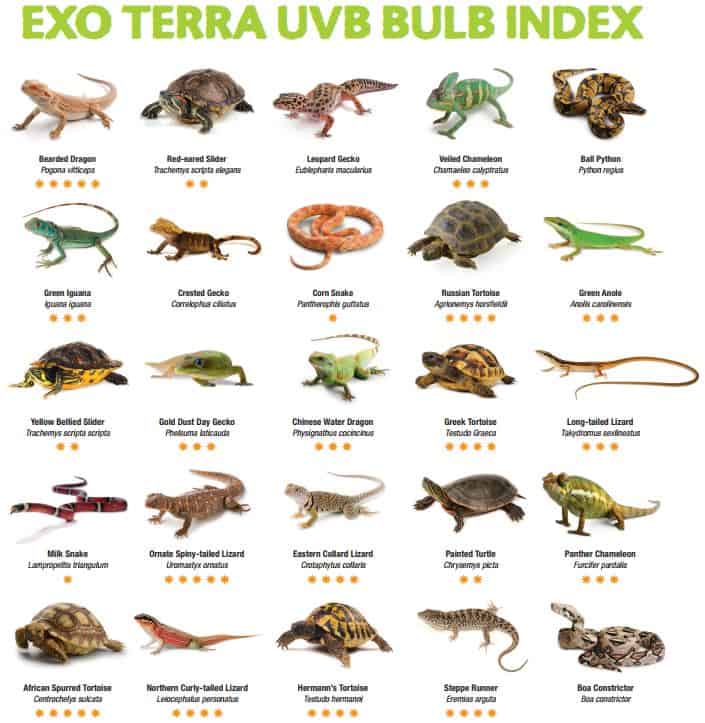
UVB requirement comparison for different reptile species –
| Reptile Name | UVB Requirement Index |
| Red Eared Slider | ** |
| Yellow Bellied Slider | ** |
| Painted Turtle | ** |
| Veiled Chameleon | *** |
| Bearded Dragon | ***** |
| Greek Tortoise, Russian Tortoise | **** |
| Hermann’s Tortoise | **** |
| African Spurred Tortoise | ***** |
Exo Terra has a series of bulbs with similar indexing system. Check out the requirements of your pets and select the suitable bulb from the list.

Frequently Asked Questions
- How much UV and visible light does the Herpeto-culture light emit?
These lights generate a wide range of UVA and UVB light source. The range for both the visible and UV spectrum for these lights range between 23-2UVA and 10-0.1UVB emission.
- Will all the UVB wavelength produce the same amount of vitamin D3?
The characteristic UVB wavelength is between 290-320Nm. However, not the entire range is equally valid to produce optimal D3 synthesis. Several researchers such as Holick and Anderson opined that the most effective UVB range for D3 integration is between 290-300Nm. At this range, the D3 integration is 60%, and it starts falling with the increase of wavelength. Over 310nm, the D3 production reduces to 5% only.
- Are the general light and lamps ineffective in producing D3 Vitamin?
No, the lamps and lights aren’t ineffective in helping the production of higher D3 vitamin. If you can set the bulbs at a proper distance and maintain the ideal heating time for the turtles, you can expect optimal D3 synthesis.
- Can I use metal halide or mercury light for my turtle?
Yes, you can use the metal halide lights to produce UVA and UVB for turtles. However, it needs to be around 100 Watts. You should expect the right amount of UVA and UVB light along with the visible light wavelength with these lights. However, metal halide lights are often very costly.
- Does the natural light component play any part in the reptiles’ health?
Some recent studies, for example, one paper in The Vivarium, suggested that sometimes the infrared radiation plays a crucial part in the thermoregulation of the reptiles. Nonetheless, more extensive research on the topic is necessary.
The Bottom Line
So, here’s the summary of the UVB lights for turtles.
First off, both UVB and UVA light are essential for the turtles. They need the two rays to regulate their body temperature, metabolism, shell longevity, mating, and breeding purpose. Without the UVB rays, they fall victim to the Vitamin D3 deficiency that weakens their shell and cause premature death.
Hence, it is essential to arrange artificial UVB sources for turtles and, too, proper precautions.
I hope that the piece of writing comes beneficial for your turtle. Once you understand the importance of proper UVB and UVA lights in the life of the turtles and help them with an appropriate source, rest assure to increase their lifespan for an extended period.
Relevant Articles:



